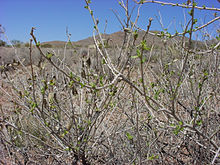Flourensia cernua
| Flourensia cernua | |
|---|---|

| |
| Scientific classification | |
| Kingdom: | Plantae |
| Clade: | Tracheophytes |
| Clade: | Angiosperms |
| Clade: | Eudicots |
| Clade: | Asterids |
| Order: | Asterales |
| Family: | Asteraceae |
| Genus: | Flourensia |
| Species: | F. cernua
|
| Binomial name | |
| Flourensia cernua DC. | |
| Synonyms[1] | |
| |
Flourensia cernua is a species of flowering plant in the aster family known by the English common names American tarwort[2] and tarbush and the Spanish common names hojasé, hojasén, and hoja ancha. It is native to the Chihuahuan Desert of North America, where it occurs in the US states of Arizona, New Mexico, and Texas, and the Mexican states of Sonora, Chihuahua, Coahuila, Durango, San Luis Potosí, and Zacatecas. Most of the species in the genus are found in Latin America; this and F. pringlei are the only two species whose ranges extend into the United States.[3][4]
Flourensia cernua is a
Flourensia cernua is winter-deciduous in most regions, but may retain its leaves in areas with sufficient moisture. The production of leaves is affected by moisture levels; the plant has been observed to produce a first set of small, scalelike leaves during a dry spring and a second set of larger leaves later in the season as moisture increases. Growth occurs earlier in the year when rainfall is abundant. Flowering occurs in the fall. The plant generally produces few flowers in dry years. The root network is shallow and vast with a few very deep roots, helping it collect water from a wide area of soil, another adaptation to its dry habitat.[3]
Flourensia cernua grows in
Flourensia cernua has medicinal uses. In Mexico it is steeped to make a tea that is consumed to treat various gastrointestinal conditions such as indigestion and diarrhea.[6] It is also used for respiratory disorders; its extracts have shown the ability to kill multidrug-resistant Mycobacterium tuberculosis in vitro.[10] The leaves and flower heads are sold in farmers' markets in Mexico and the United States.[11]
In agriculture, this shrub has been studied as a potential supplemental forage for livestock such as sheep. The fact that it is increasing in abundance in the Chihuahuan Desert has sparked interest in its value as food for local domestic animals. It is similar to alfalfa in nutritional value[7] being high in protein.[8] However, it contains compounds that reduce its palatability to animals, making it bitter and "peppery".[3] In addition, the flowers and fruits are toxic to sheep, goats, and cattle.[3][11] Livestock naturally avoid it.[3] The leaves can be consumed in moderation for their nutritional value, but a diet composed only of tarbush can be fatal.[3]
Compounds isolated from the plant include
References
- ^ The Plant List, Flourensia cernua DC.
- ^ USDA, NRCS (n.d.). "Flourensia cernua". The PLANTS Database (plants.usda.gov). Greensboro, North Carolina: National Plant Data Team. Retrieved 15 July 2015.
- ^ a b c d e f g h i j k Innes, Robin J. 2010. Flourensia cernua. In: Fire Effects Information System, [Online]. U.S. Department of Agriculture, Forest Service, Rocky Mountain Research Station, Fire Sciences Laboratory.
- ^ SEINet, Southwestern Biodiversity, New Mexico Biodiversity Portal - Flourensia cernua includes photos, description, distribution map
- ^ a b c Flourensia cernua. Flora of North America.
- ^ PMID 12946427.
- ^ .
- ^ JSTOR 4002592.
- PMID 15277246.
- PMID 16314185.
- ^ .
- S2CID 12737178.

